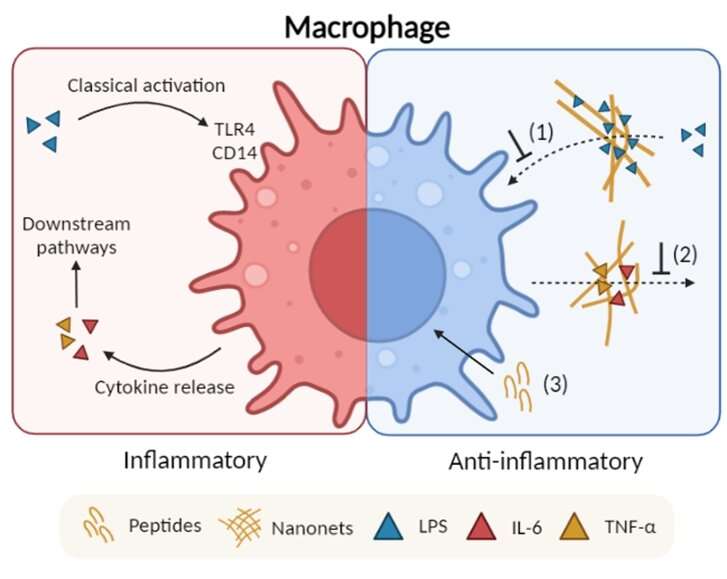This article has been reviewed according to Science X's editorial process and policies. Editors have highlighted the following attributes while ensuring the content's credibility:
fact-checked
peer-reviewed publication
trusted source
proofread
Antimicrobial nanonets display multifunctionality by mitigating inflammatory responses during sepsis

National University of Singapore (NUS) pharmaceutical scientists have developed multi-functional synthetic peptide nanonets for relieving inflammation caused by bacterial infection. This is achieved by concurrent trapping of bacterial endotoxins and pro-inflammatory cytokines.
Endotoxemia is characterized by the presence of endotoxins in the blood. These endotoxins can be released by gram-negative pathogens such as E. coli during systemic infections. When left unchecked, inflammatory host responses can result in extensive tissue damage and septic shock, which are associated with a high mortality rate. Unfortunately, past research efforts to develop targeted therapies against sepsis have largely been unsuccessful due to the complex nature of interactions between pro- and anti-inflammatory mediators.
A more recent approach focuses on multi-cytokine for better management of septic complications. A research team led by Associate Professor Rachel Ee from the Department of Pharmacy, NUS demonstrated that antibacterial peptide nanonets could possess additional functionalities to mitigate inflammatory responses that are commonly associated with bacterial infections.
These findings are built on the team's previous report of the design of anti-microbial peptides capable of in situ self-assembly into bacteria-trapping nanonets. Anti-inflammatory activity was achieved through the ability of the nanonets to bind and entrap endotoxins released by gram-negative pathogens, and inflammation mediators produced by host macrophages. Of interest, the cationic nanonets selectively entrapped pro-inflammatory cytokines while minimally binding the anti-inflammatory cytokines. The team achieved this desirable specificity by capitalizing on the overall difference in net charge between these two different groups of cytokines.
The new study is published in the journal Advanced Healthcare Materials.
Additionally, the lipopolysaccharide (LPS)-binding effect resulted in the restoration of antimicrobial activity of colistin, a last-line therapy, against gram-negative pathogens. Notably, this is the first reported instance of multi-functional peptide nanonets with long-ranging effects in alleviating the damages of septic complications at multiple stages. Biological evaluations of the peptide nanonets using an acute lung injury model demonstrated their efficacy in lowering the level of pro-inflammatory cytokines in the bronchoalveolar fluid of endotoxin-inoculated murine models. The resulting peptide effect was comparable to the control drug dexamethasone.
Prof. Ee said, "Our peptide-based nanonets have shown unique therapeutic potential as a multi-functional biomaterial for holistic management of sepsis. Moving forward, we hope to continue their optimization for clinical use."
More information: Nhan Dai Thien Tram et al, Multifunctional Antibacterial Nanonets Attenuate Inflammatory Responses through Selective Trapping of Endotoxins and Pro‐Inflammatory Cytokines, Advanced Healthcare Materials (2023). DOI: 10.1002/adhm.202203232
Journal information: Advanced Healthcare Materials
Provided by National University of Singapore




















